2009 FIAT SEDICI battery
[x] Cancel search: batteryPage 215 of 270
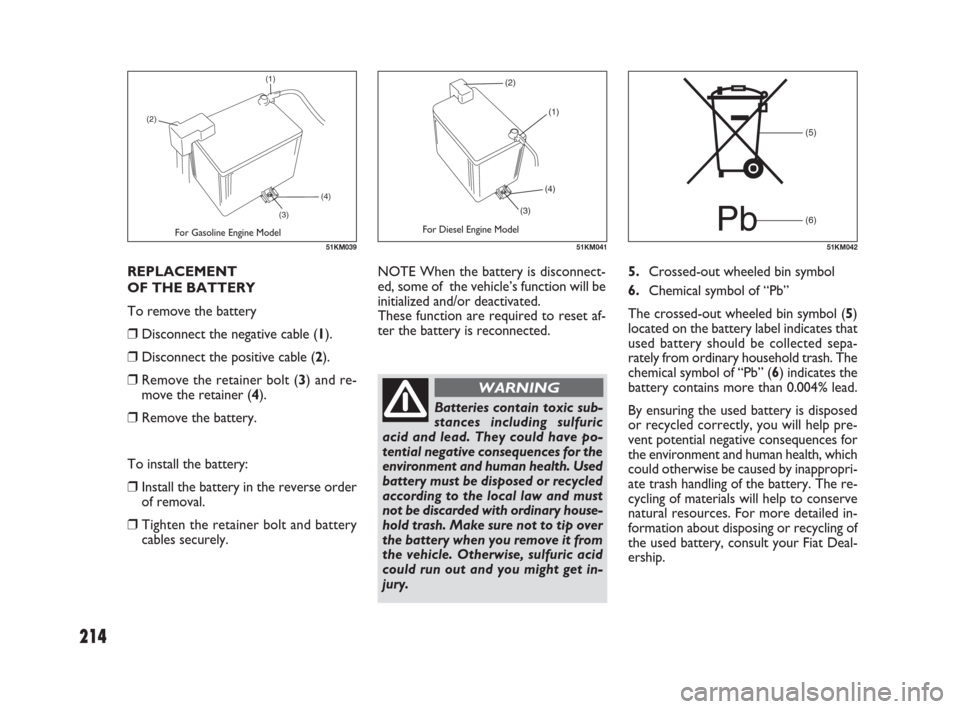
214
Batteries contain toxic sub-
stances including sulfuric
acid and lead. They could have po-
tential negative consequences for the
environment and human health. Used
battery must be disposed or recycled
according to the local law and must
not be discarded with ordinary house-
hold trash. Make sure not to tip over
the battery when you remove it from
the vehicle. Otherwise, sulfuric acid
could run out and you might get in-
jury.
WARNING
(1)
(2)
(3)
(4)
51KM039
(1)
(2)
(4)
(3)
51KM041
Pb
(5)
(6)
51KM042
REPLACEMENT
OF THE BATTERY
To remove the battery
❒ Disconnect the negative cable (1).
❒ Disconnect the positive cable (2).
❒ Remove the retainer bolt (3) and re-
move the retainer (4).
❒ Remove the battery.
To install the battery:
❒ Install the battery in the reverse order
of removal.
❒ Tighten the retainer bolt and battery
cables securely.5.Crossed-out wheeled bin symbol
6.Chemical symbol of “Pb”
The crossed-out wheeled bin symbol (5)
located on the battery label indicates that
used battery should be collected sepa-
rately from ordinary household trash. The
chemical symbol of “Pb” (6) indicates the
battery contains more than 0.004% lead.
By ensuring the used battery is disposed
or recycled correctly, you will help pre-
vent potential negative consequences for
the environment and human health, which
could otherwise be caused by inappropri-
ate trash handling of the battery. The re-
cycling of materials will help to conserve
natural resources. For more detailed in-
formation about disposing or recycling of
the used battery, consult your Fiat Deal-
ership. NOTE When the battery is disconnect-
ed, some of the vehicle’s function will be
initialized and/or deactivated.
These function are required to reset af-
ter the battery is reconnected.
For Gasoline Engine ModelFor Diesel Engine Model
183-230 SEDICI LUM FL GB 1E 19-06-2009 11:00 Pagina 214
Page 216 of 270
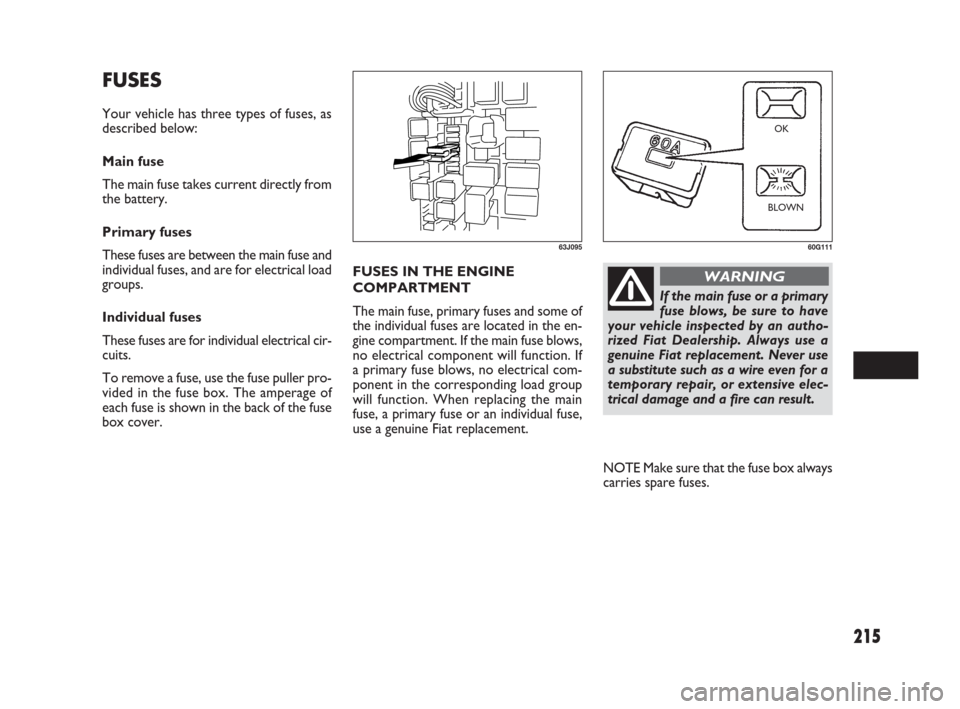
215
FUSES IN THE ENGINE
COMPARTMENT
The main fuse, primary fuses and some of
the individual fuses are located in the en-
gine compartment. If the main fuse blows,
no electrical component will function. If
a primary fuse blows, no electrical com-
ponent in the corresponding load group
will function. When replacing the main
fuse, a primary fuse or an individual fuse,
use a genuine Fiat replacement.
60G111
OK
BLOWN
If the main fuse or a primary
fuse blows, be sure to have
your vehicle inspected by an autho-
rized Fiat Dealership. Always use a
genuine Fiat replacement. Never use
a substitute such as a wire even for a
temporary repair, or extensive elec-
trical damage and a fire can result.
WARNING
FUSES
Your vehicle has three types of fuses, as
described below:
Main fuse
The main fuse takes current directly from
the battery.
Primary fuses
These fuses are between the main fuse and
individual fuses, and are for electrical load
groups.
Individual fuses
These fuses are for individual electrical cir-
cuits.
To remove a fuse, use the fuse puller pro-
vided in the fuse box. The amperage of
each fuse is shown in the back of the fuse
box cover.
63J095
NOTE Make sure that the fuse box always
carries spare fuses.
183-230 SEDICI LUM FL GB 1E 19-06-2009 11:00 Pagina 215
Page 234 of 270
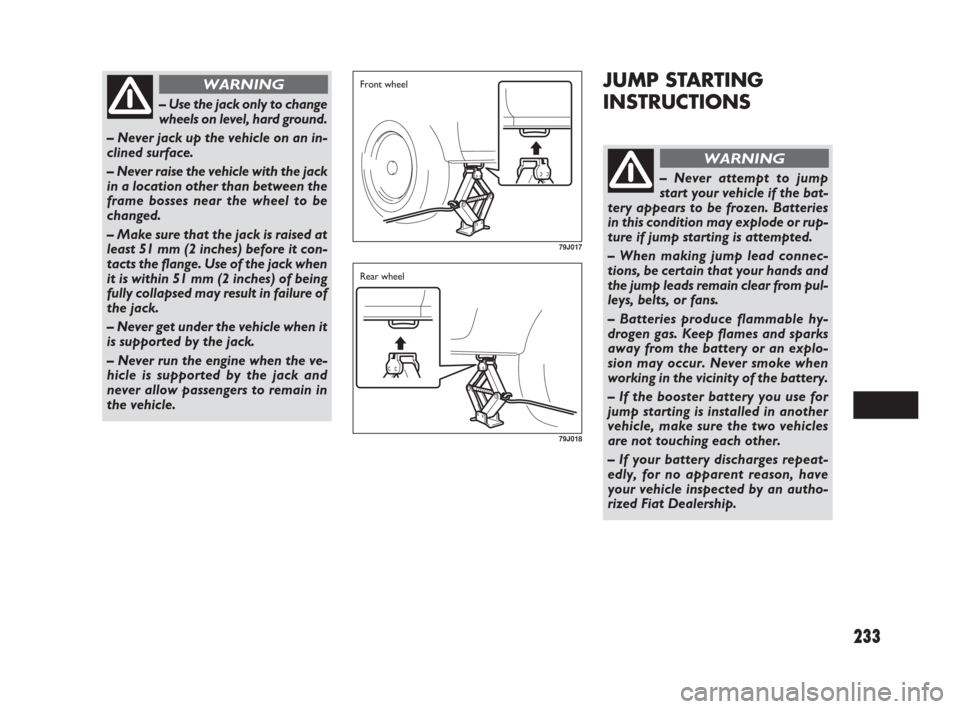
233
JUMP STARTING
INSTRUCTIONS
– Use the jack only to change
wheels on level, hard ground.
– Never jack up the vehicle on an in-
clined surface.
– Never raise the vehicle with the jack
in a location other than between the
frame bosses near the wheel to be
changed.
– Make sure that the jack is raised at
least 51 mm (2 inches) before it con-
tacts the flange. Use of the jack when
it is within 51 mm (2 inches) of being
fully collapsed may result in failure of
the jack.
– Never get under the vehicle when it
is supported by the jack.
– Never run the engine when the ve-
hicle is supported by the jack and
never allow passengers to remain in
the vehicle.
WARNING
79J017
79J018
Front wheel
Rear wheel
– Never attempt to jump
start your vehicle if the bat-
tery appears to be frozen. Batteries
in this condition may explode or rup-
ture if jump starting is attempted.
– When making jump lead connec-
tions, be certain that your hands and
the jump leads remain clear from pul-
leys, belts, or fans.
– Batteries produce flammable hy-
drogen gas. Keep flames and sparks
away from the battery or an explo-
sion may occur. Never smoke when
working in the vicinity of the battery.
– If the booster battery you use for
jump starting is installed in another
vehicle, make sure the two vehicles
are not touching each other.
– If your battery discharges repeat-
edly, for no apparent reason, have
your vehicle inspected by an autho-
rized Fiat Dealership.
WARNING
231-238 SEDICI LUM FL GB 1E 19-06-2009 11:06 Pagina 233
Page 235 of 270

234
❒Turn off all vehicle accessories, except
those necessary for safety reasons (for
example, headlights or hazard lights).
❒Make jump lead connections as follows:
– Connect one end of the first jump
lead to the positive (+) terminal of
the flat battery (1).
– Connect the other end to the posi-
tive (+) terminal of the booster bat-
tery (2).
– Connect one end of the second jump
lead to the negative (–) terminal of
the booster battery (2).
– Make the final connection to an un-
painted, heavy metal part (i. e. engine
hook (3)) of the engine of the vehi-
cle with the flat battery (1).
❒If the booster battery you are using is
fitted to another vehicle, start the en-
gine of the vehicle with the booster bat-
tery. Run the engine at moderate
speed.
❒Start the engine of the vehicle with the
flat battery.
❒Remove the jump leads in the exact re-
verse order in which you connected
them. IMPORTANT Your vehicle should not be
started by pushing or towing. This start-
ing method could result in permanent
damage to the catalytic converter. Use
jump leads to start a vehicle with a weak
or flat battery.
WHEN JUMP STARTING YOUR
VEHICLE, USE THE
FOLLOWING PROCEDURE
❒Use only a 12 volt battery to jump start
your vehicle. Position the good 12 V
battery close to your vehicle so that the
jump leads will reach both batteries.
When using a battery installed on an-
other vehicle, DO NOT LET THE VE-
HICLES TOUCH. Set the parking
brakes fully on both vehicles.
– To avoid harm to yourself
or damage to your vehicle or
battery, follow the jump starting in-
structions below precisely and in order.
If you are in doubt, call for qualified
road service.
WARNING
(1)
(3)
(2)
54G079
Never connect the jump lead
directly to the negative (–)
terminal of the discharged battery, or
an explosion may occur.
WARNING
231-238 SEDICI LUM FL GB 1E 19-06-2009 11:06 Pagina 234
Page 237 of 270
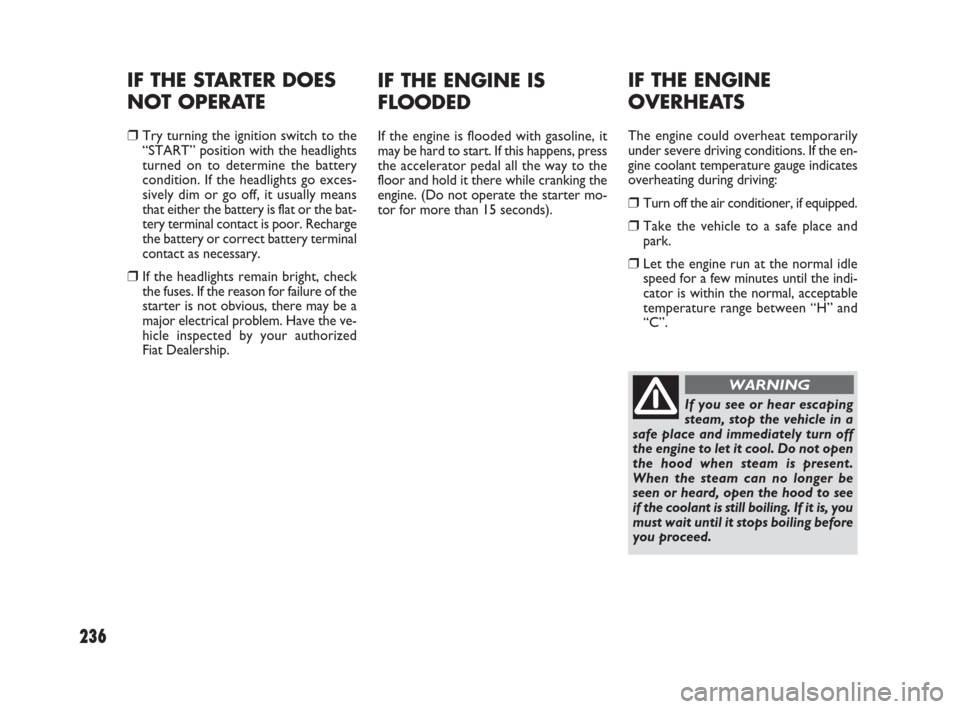
236
IF THE ENGINE
OVERHEATS
The engine could overheat temporarily
under severe driving conditions. If the en-
gine coolant temperature gauge indicates
overheating during driving:
❒Turn off the air conditioner, if equipped.
❒Take the vehicle to a safe place and
park.
❒Let the engine run at the normal idle
speed for a few minutes until the indi-
cator is within the normal, acceptable
temperature range between “H” and
“C”.
IF THE ENGINE IS
FLOODED
If the engine is flooded with gasoline, it
may be hard to start. If this happens, press
the accelerator pedal all the way to the
floor and hold it there while cranking the
engine. (Do not operate the starter mo-
tor for more than 15 seconds).
If you see or hear escaping
steam, stop the vehicle in a
safe place and immediately turn off
the engine to let it cool. Do not open
the hood when steam is present.
When the steam can no longer be
seen or heard, open the hood to see
if the coolant is still boiling. If it is, you
must wait until it stops boiling before
you proceed.
WARNING
IF THE STARTER DOES
NOT OPERATE
❒Try turning the ignition switch to the
“START” position with the headlights
turned on to determine the battery
condition. If the headlights go exces-
sively dim or go off, it usually means
that either the battery is flat or the bat-
tery terminal contact is poor. Recharge
the battery or correct battery terminal
contact as necessary.
❒If the headlights remain bright, check
the fuses. If the reason for failure of the
starter is not obvious, there may be a
major electrical problem. Have the ve-
hicle inspected by your authorized
Fiat Dealership.
231-238 SEDICI LUM FL GB 1E 19-06-2009 11:06 Pagina 236
Page 239 of 270

238
(1)
68KM037
(1)
68KM038
IF YOU CANNOT
SHIFT AUTOMATIC
TRANSAXLE
GEARSHIFT LEVER
OUT OF “P” (PARK)
Left Hand Drive Vehicle
Vehicles with an automatic transaxle have
an electrically operated park- lock feature.
If the vehicle’s battery is discharged, or
there is some other electrical failure, the
automatic transaxle cannot be shifted out
of Park in the normal way. Jump starting
may correct the condition. If not, follow
the procedure described below. This pro-
cedure will permit shifting the transaxle
out of Park.
❒Be sure the parking brake is firmly ap-
plied.
❒If the engine is running, stop the engine.
❒Make sure the key is in the “ON” or
“ACC” position.
❒Remove the cover (1) over the button.
❒With pushing the release button by the
key or the flat end rod, shift the
gearshift lever to the desired position.This procedure is for emergency use on-
ly. If repeated use of this procedure is nec-
essary, or the procedure does not work
as described, take the vehicle to your deal-
er for repair.
Right Hand Drive Vehicle
Vehicles with an automatic transaxle have
an electrically operated park- lock feature.
If the vehicle’s battery is discharged, or
there is some other electrical failure, the
automatic transaxle cannot be shifted out
of Park in the normal way. Jump starting
may correct the condition. If not, follow
the procedure described below. This pro-
cedure will permit shifting the transaxle
out of Park.
❒Be sure the parking brake is firmly ap-
plied.
❒If the engine is running, stop the engine.
❒Make sure the key is in the “ON” or
“ACC” position.
❒With pushing the release button (1),
shift the gearshift lever to the desired
position.
This procedure is for emergency use on-
ly. If repeated use of this procedure is nec-
essary, or the procedure does not work
as described, take the vehicle to your deal-
er for repair.
231-238 SEDICI LUM FL GB 1E 19-06-2009 11:06 Pagina 238
Page 244 of 270
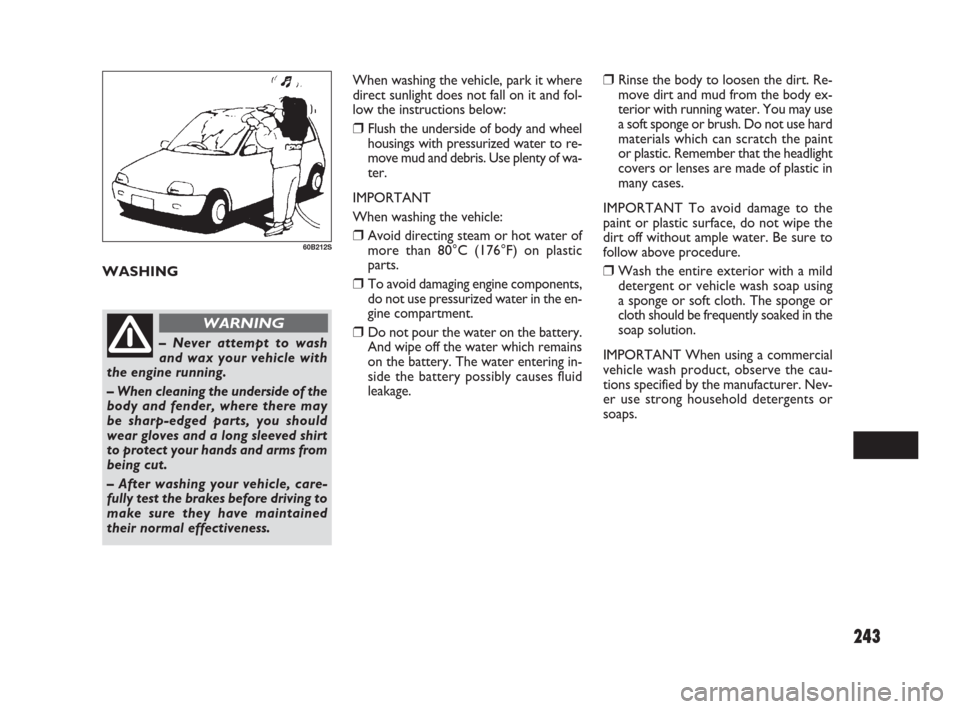
243
When washing the vehicle, park it where
direct sunlight does not fall on it and fol-
low the instructions below:
❒Flush the underside of body and wheel
housings with pressurized water to re-
move mud and debris. Use plenty of wa-
ter.
IMPORTANT
When washing the vehicle:
❒Avoid directing steam or hot water of
more than 80°C (176°F) on plastic
parts.
❒To avoid damaging engine components,
do not use pressurized water in the en-
gine compartment.
❒Do not pour the water on the battery.
And wipe off the water which remains
on the battery. The water entering in-
side the battery possibly causes fluid
leakage.
❒Rinse the body to loosen the dirt. Re-
move dirt and mud from the body ex-
terior with running water. You may use
a soft sponge or brush. Do not use hard
materials which can scratch the paint
or plastic. Remember that the headlight
covers or lenses are made of plastic in
many cases.
IMPORTANT To avoid damage to the
paint or plastic surface, do not wipe the
dirt off without ample water. Be sure to
follow above procedure.
❒Wash the entire exterior with a mild
detergent or vehicle wash soap using
a sponge or soft cloth. The sponge or
cloth should be frequently soaked in the
soap solution.
IMPORTANT When using a commercial
vehicle wash product, observe the cau-
tions specified by the manufacturer. Nev-
er use strong household detergents or
soaps.
– Never attempt to wash
and wax your vehicle with
the engine running.
– When cleaning the underside of the
body and fender, where there may
be sharp-edged parts, you should
wear gloves and a long sleeved shirt
to protect your hands and arms from
being cut.
– After washing your vehicle, care-
fully test the brakes before driving to
make sure they have maintained
their normal effectiveness.
WARNING
60B212S
WASHING
239-244 SEDICI LUM FL GB 1E 19-06-2009 11:08 Pagina 243
Page 252 of 270
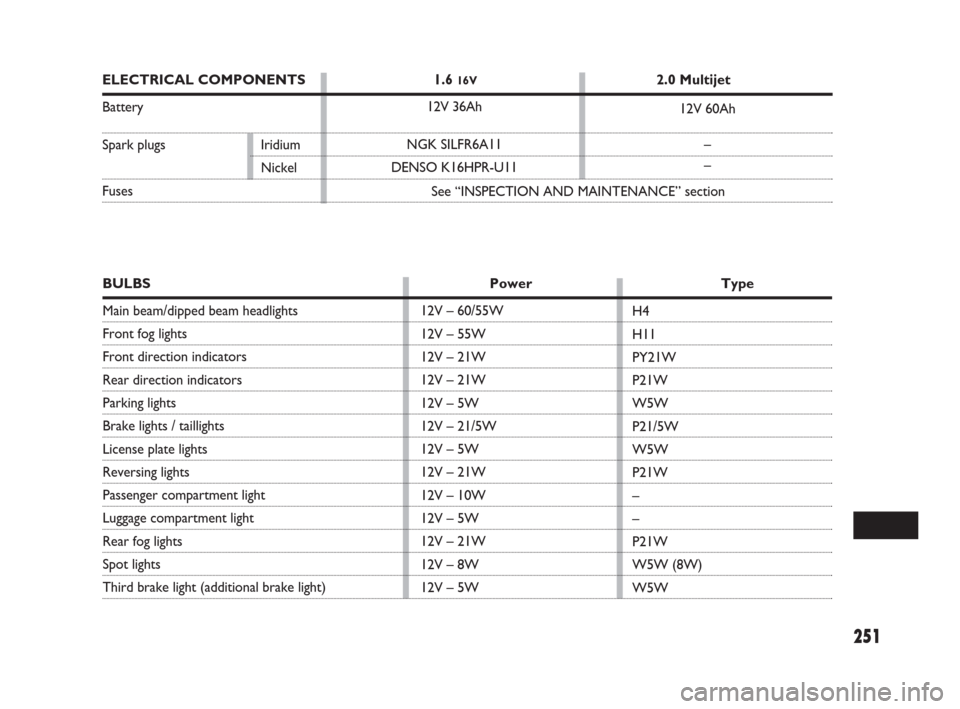
251
12V – 60/55W
12V – 55W
12V – 21W
12V – 21W
12V – 5W
12V – 21/5W
12V – 5W
12V – 21W
12V – 10W
12V – 5W
12V – 21W
12V – 8W
12V – 5WH4
H11
PY21W
P21W
W5W
P21/5W
W5W
P21W
–
–
P21W
W5W (8W)
W5W
BULBS Power Type
Main beam/dipped beam headlights
Front fog lights
Front direction indicators
Rear direction indicators
Parking lights
Brake lights / taillights
License plate lights
Reversing lights
Passenger compartment light
Luggage compartment light
Rear fog lights
Spot lights
Third brake light (additional brake light)
ELECTRICAL COMPONENTS 1.6 16V2.0 Multijet
Battery
Spark plugs Iridium
Nickel
Fuses12V 36Ah
NGK SILFR6A11
DENSO K16HPR-U1112V 60Ah
–
–
See “INSPECTION AND MAINTENANCE” section
249-254 SEDICI LUM FL GB 1E 19-06-2009 11:10 Pagina 251